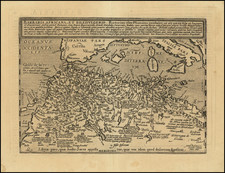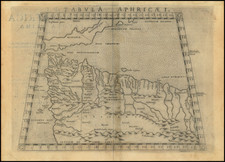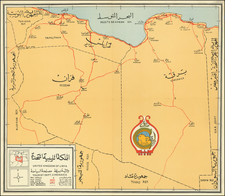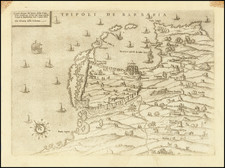Remarkable Manuscript Collection of the French Invasion of Algeria, From the Collection of the Duke of Orléans
Striking collection of 46 manuscript maps, and a few documents, showing northern Algeria. The maps date from the French invasion of Algeria (1830-1847) and originate from Prince Ferdinand Philippe, Duke of Orléans, who most likely used them to prepare his history of the conflict. They represent a noteworthy body of knowledge about this significant episode in the history of Algeria and of the French Empire.
The maps are predominantly written in French, with some items in Arabic. The collection includes subsets of maps focused on Algiers and its surroundings, and maps focused on northeastern Algeria. These particular areas were the site of intense fighting between the French army and Algerian resistance forces during the French conquest of Algeria.
Maps in this collection include:
- Plans and views of Algiers
- Locations of French military encampments
- Strategic towns around Algiers including Blida, Medea, Kolea, and Boufarik
- Resistance-held towns across northern Algeria, including Constantine
- Major waterways, coastal areas, and routes between towns in northern Algeria
This collection most likely belonged to Prince Ferdinand Philippe, the Duke of Orléans, the eldest son of the French King Louis Philippe I (r. 1830-1848). Prince Ferdinand Philippe spent most of his notable military career in Algeria. He then spent his post-military life compiling a history of the French conquest of Algeria and accounts of his military campaigns. When he died at the young age of 32, the collection would have stayed within the family, eventually finding a home in the library of Ferdinand’s youngest brother, Antoine, Duke of Montpensier.
This is a fine view of the lighthouse and fortifications of Algiers, the largest city in Algeria. It is drawn with considerable skill by a Captain Signoret. This is Captain Jean-Baptiste Signoret, who was a witness to a central moment in the French-Algeria conflict (see below).
France and Algeria in the nineteenth century
The bustling port city of Algiers, and what would become the country of Algeria, was an autonomous region of the Ottoman Empire at the beginning of the nineteenth century. Its provincial ruler (dey) controlled Algiers and its surroundings; numerous inland tribal leaders pledged loyalty to the Sultan in Constantinople. Along the Barbary Coast, piracy and the slave trade were the main economic activities and the source of Algiers’ wealth, along with the region’s considerable wheat crops. European powers and the United States sought to end Algerian privateering and Christian slavery and took naval action against Algiers and the Barbary corsairs in 1815.
Relations between France and Algiers had flourished during the Napoleonic Wars with Algiers benefitting from France’s large food import demands. Trouble began when France bought fourteen million pounds of wheat on credit from two traders in Algiers, Bacri and Busnach, but refused to pay back the debt. Bacri and Busnach were themselves in debt to the Ottoman ruler in Algiers and unable to pay until France paid them, leading to mounting tensions between Algiers and France.
The 1827 “Fly Whisk Incident”
On April 29, 1827 the Ottoman ruler in Algiers, Dey Hussein ben Hassan, slapped the French consul Pierre Deval with his fly whisk (a switch-like tool commonly used to swat flies). Dey Hassan was angry over the longstanding French debt and Deval had recently strained relations further by supervising illegal fortification of French trading posts on the Dey’s territory. Accounts claim that the two men exchanged insults, leading to the Dey striking Deval.
For the French, this diplomatic faux pas represented an opportunity: the French were concerned about British political and commercial influence in North Africa, veterans of the Napoleonic wars needed employment, and the current monarchy could use an overseas entanglement to direct public attention away from issues at home. The Fly Whisk Incident set off a years-long French naval barricade and embargo of the port of Algiers. After failed negotiations in July of 1829, the King’s emissary, Captain de la Bretonnière, was fired upon by Ottoman Algerian forces; the French then began their conquest of Algeria in 1830.
Importantly, two views of Algiers included in this collection (here and here) were authored by Captain Jean-Baptiste Signoret, who was on the Provence with Captain de la Bretonnière during the failed negotiations. Signoret was able to capture a pivotal moment in the history of French-Algerian relations.
French conquest of Algeria (1830-1847)
On June 4, 1830, the French army, led by General de Bourmont, landed about fifteen miles west of Algiers in Sidi-Ferruch and was met by opposition from Ottoman Janissary and native Kabyle forces. Fighting lasted for three weeks, with Algerian forces sustaining major losses. Dey Hassan was forced to surrender, and the French took control of Algiers on July 5, 1830.
Just two weeks after capturing Algiers, the Bourbon monarchy of Charles X fell to the “Citizen King” Louis Philippe, who decided to continue the inherited military campaign. However, native Algerian resistance to French colonization proved difficult for the French forces to battle. At the time of formal annexation in 1934, for example, French occupation was still confined mainly to coastal towns and isolated outposts.
Emir Abdelkader was the religious and military leader of the Algerian guerilla resistance and at one point his forces controlled more than two-thirds of Algerian territory. The French military fought a drawn-out, bloody battle against Abdelkader and other resistance forces which eventually ended with Abdelkader’s surrender in 1847.
Ferdinand Philippe, Duke of Orléans: Military success and a tragic early death
Prince Ferdinand Philippe d’Orléans, Duke of Orléans (1810-1842), was the son of King Louis Philippe I and Maria Amalia of Naples and Sicily. Ferdinand Philippe was born in Sicily while his parents were in exile, but he and his family returned to Paris after the fall of Napoleon in 1815. He married Princess Helen of Mecklenburg-Schwerin in 1837 and had two sons, Philippe, Count of Paris, and Robert, Duke of Chartres.
Ferdinand Philippe’s father, the aforementioned “Citizen King”, became the reigning monarch following the July Revolution of 1830 and the abdication of his cousin, Charles X. King Louis Philippe I was well known for his support of colonial expansion, particularly the French conquest of Algeria. As heir apparent, Ferdinand Philippe dedicated much of his military career to Algerian colonization, completing three tours: 1835-1836, 1839, and 1840. Ferdinand Philippe is perhaps most famous for his efforts to conquer Algeria’s interior from Constantine to Algiers, breaking the Treaty of Tafna between France and Algerian resistance leader Emir Abdelkader and precipitating the complete conquest of Algeria by French forces.
Ferdinand Philippe enjoyed tremendous popularity among citizens of France for his unwavering support of French troops and veterans, as well as for his own military bravery, charity work, and patronage of the arts.
In 1842, at just 32, he was thrown from an out-of-control carriage and died shortly afterward in Neuilly-sur-Seine, France. Ferdinand Philippe’s passing was deeply mourned by both elites and the French populace, who had seen the Prince as a promising successor to the throne: a charismatic, respected military leader and liberal thinker who would lead France in a new direction. His passing is widely viewed as changing the course of French history and signaled the ultimate demise of French monarchic rule. Without the beloved young prince, King Louis Philippe lacked crucial popular support, leading to the regime’s downfall in 1848 and the subsequent rise of Napoleon III.
Provenance and history of the collection
This collection was in the possession of Ferdinand Philippe’s youngest brother, Antoine, Duke of Montpensier. At the time of Ferdinand Philippe’s death, his sons were very young; passing his military library to his youngest brother would have been typical.
Ferdinand Philippe had spent time compiling a history of the French conquest of Algeria, published by his sons in 1870 as Campagnes de l'armée d'Afrique: 1835-1839. Ferdinand Philippe also wrote detailed accounts of each of his military campaigns which were published shortly after his death and then later republished by his sons.
This collection of maps, views, and documents details the same areas included in Ferdinand Philippe’s written works. Some of this collection appears to be from Ferdinand Philippe’s own military service, and other items appear to have been gathered to support his research and writing. Many of the items in this collection are focused on areas under Emir Abdelkader’s control, particularly the area from Constantine to Algiers where Ferdinand Philippe led an 1839 expedition to capture Abdelkader’s territory.
The collection itself survived the Orléans family exile from France after the Revolution of 1848, making its way with Antoine, Duke of Montpensier, to his new home in Spain.
The history of this collection is not only fascinating, but the collection itself is of substantial historical importance. Its numerous maps and military manuscripts detail the on-the-ground workings of the French military in Algeria, telling the story of French conquest and Algerian resistance. Viewing this collection as a whole, collectors can deeply engage with both the history of French Algeria and with that of the Orléans family.
Algeria Manuscript Map Collection, from the collection of the Duke of Montpensier
Striking collection of 46 manuscript maps, and a few documents, showing northern Algeria. The maps date from the French invasion of Algeria (1830-1847) and originate from Prince Ferdinand Philippe, Duke of Orléans, who most likely used them to prepare his history of the conflict. They represent a noteworthy body of knowledge about this significant episode in the history of Algeria and of the French Empire. The maps are predominantly written in French, with some items in Arabic. The collection includes subsets of maps focused on Algiers and its surroundings, and maps focused on northeastern Algeria. These particular areas were the site of intense fighting between the French army and Algerian resistance forces during the French conquest of Algeria. Maps in this collection include: Plans and views of Algiers Locations of French military encampments Strategic towns around Algiers including Blida, Medea, Kolea, and Boufarik Resistance-held towns across northern Algeria, including Constantine Major waterways, coastal areas, and routes between towns in northern Algeria This collection most likely belonged to Prince Ferdinand Philippe, the Duke of Orléans, the eldest son of the French King Louis Philippe I (r. 1830-1848). Prince Ferdinand Philippe spent most of his notable military career in Algeria. He then spent his post-military life compiling a history of the French conquest of Algeria and accounts of his military campaigns. When he died at the young age of 32, the collection would have stayed within the family, eventually finding a home in the library of Ferdinand’s youngest brother, Antoine, Duke of Montpensier.











![[With Early Annotations!] Nuova et Copiosa Descrittione Di Tutto L'Egitto Pur hora de Paulo Forlani Veronese intagliata in Venetia lanno 1566](https://storage.googleapis.com/raremaps/img/small/75556.jpg)
![Fezzae et Marocchi Regna Africae Celeberrima, describebat Abrah: Ortelius. [Fez and Morocco, the most famous Kingdoms of Africa, as described by Abraham Ortelius]](https://storage.googleapis.com/raremaps/img/small/94255.jpg)

